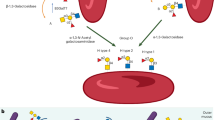Abstract
Chemical structures of the sugar chains of various human alpha-fetoprotein (AFP) species with different affinity for Concanavalin A (Con A) and Lens culinaris agglutinin (LCA) were examined by pyridylamination of their oligosaccharides and stepwise exoglycosidase digestion. Using reversed-phase and size-fractionation high performance liquid chromatography systems we identified six pyridylamino-sugar chains. The Con A-reactive and LCA-nonreactive species of AFP from patients with hepatocellular carcinoma contained a biantennary sugar chain, and the Con A-reactive and LCA-reactive species had a biantennary one with a fucose residue at the innermost N-acetylglucosamine residue. The Con A-nonreactive and LCA-reactive species contained a biantennary sugar chain both with a bisecting-N-acetylglucosamine residue at the trimannosyl core and with a focus residue at the innermost N-acetylglucosamine residue. The Con A-nonreactive and LCA-nonreactive species contained a fucosylated triantennary sugar chain as a major component, and two minor components: a triantennary sugar chain and a biantennary sugar chain with a bisecting-N-acetylglucosamine residue at the trimannosyl core. Thus, the fucosylated and non-fucosylated triantennary sugar chains were newly identified in human AFP. Essentially identical results were obtained for AFP from the patient with gallbladder carcinoma which metastasizes to the liver. These results indicate that the increment in fucosylation and branching to form new antennae is a characteristic feature of the carbohydrate chains of AFP from patients with neoplastic diseases of the liver.
This is a preview of subscription content, access via your institution
Access options
Subscribe to this journal
Receive 24 print issues and online access
$259.00 per year
only $10.79 per issue
Buy this article
- Purchase on Springer Link
- Instant access to full article PDF
Prices may be subject to local taxes which are calculated during checkout
Similar content being viewed by others
Author information
Authors and Affiliations
Rights and permissions
About this article
Cite this article
Aoyagi, Y., Suzuki, Y., Igarashi, K. et al. Carbohydrate structures of human α-fetoprotein of patients with hepatocellular carcinoma: presence of fucosylated and non-fucosylated triantennary glycans. Br J Cancer 67, 486–492 (1993). https://doi.org/10.1038/bjc.1993.91
Issue Date:
DOI: https://doi.org/10.1038/bjc.1993.91
This article is cited by
-
A pilot study of salivary N-glycome in HBV-induced chronic hepatitis, cirrhosis, and hepatocellular carcinoma
Glycoconjugate Journal (2017)
-
Glycomic profiling of carcinoembryonic antigen isolated from human tumor tissue
Clinical Proteomics (2015)
-
Clinical value of hepatoma-specific alpha-fetoprotein in the diagnosis of hepatocellular carcinoma
Chinese Journal of Clinical Oncology (2006)
-
Carbohydrate-based measurements on alpha-fetoprotein in the early diagnosis of hepatocellular carcinoma
Glycoconjugate Journal (1995)



